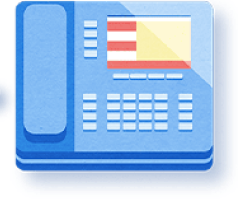
The technology housed within call centers today is leaps and bounds beyond what it has ever been before. Unfortunately, the cyberattacks are equally more advanced, which means ensuring your call center security is up to date is of paramount importance. To that end, learn everything you need to know about the threats modern call centers face, along with some best practices for securing yourself against those threats.
Understanding the Threats that Call Centers Face
For those who have never yet faced a security threat against the phones within your call center, it can be easy to brush the potential threat aside. However, there are many potential threats a call center may face. The most common cyberattacks call centers may experience include:
- General Hacking: Sometimes, the strongest threat is the oldest threat. Standard hacking attacks, where sensitive caller data is stolen, can cause reputational and monetary losses.
- Phishing Attacks: Phishing attacks occur when a hacker deceives employees into sharing private data by pretending to be a loved one or invoking an emotional response from the employee. Phishing attacks most commonly occur over the phone or by email and attempt to lure the target into clicking on a link or sending information.
- Ransomware: Alternatively, ransomware attacks occur when hackers lock the proper company out of their own systems and only release those systems when they are paid a certain amount or given certain information.
- TDoS Attack: Finally, a TDoS attack occurs when hackers bombard call centers with a high volume of calls using bots so that genuine calls cannot come through or go out, thus halting business operations.
Best Practices for Call Center Security
Each of the above cyberattacks can cause frustrations along with monetary losses for your call center, which is why learning to bolster security is so important. To reduce the risk of falling victim to a cyberattack, implement the following six best practices at your organization:
- Utilize two-factor authentication: Two-factor authentication is a simple yet often overlooked method of securing data. Essentially, this just means requiring an additional verification from someone attempting to access company servers, such as both a password and rotating keycode or something similar.
- Invest in data encryption: Data encryption can be expensive to invest in, but it essentially operates as insurance, helping to reduce your risk of losing hundreds of thousands of dollars’ worth of data.
- Conduct regular cybersecurity training: Employees are the first line of defense for most organizations, which is why annual cybersecurity training is crucial. Introduce your employees to the common attacks they may face so they can recognize the signs of when one is occurring.
- Build out a secure infrastructure: Use IT experts to diagnose potential issues in your current call center infrastructure so that the potential gaps in security may be fixed.
- Secure your phone lines with VOIP security: Voice Over Internet Protocol or VOIP is a modern technology that allows calls to be made via the Internet rather than a hard-wired connection. There are security risks with this technology, though, so purchase phone line security when investing in VOIP technology.
- Make use of call recording and storage: Finally, in the event data is successfully stolen from your call center, having recordings and data stored in a separate and secure location can allow business operations to resume quicker, thus resulting in fewer monetary losses.
Enhance the Security of Your Call Center Right Away
With every passing day, the cyberattacks launched against organizations around the world become increasingly more sophisticated. Keeping up to date with these attacks means keeping your security equally up to date, but this can be challenging without subject matter expertise. Fortunately, if your business is located in the Akron, Columbus, or Cleveland areas and needs help bolstering the security of your call center, you can contact us at Warwick right away for all your needs.

 800.860.0300
800.860.0300  800.860.0300
800.860.0300 








